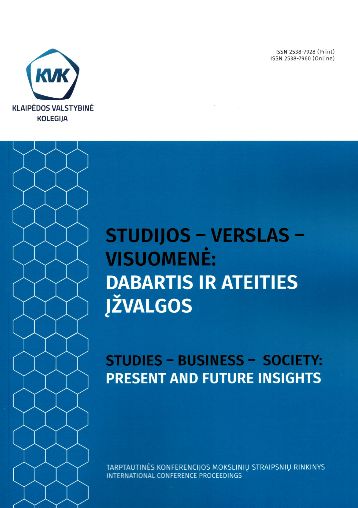NORMINIŲ IR NENORMINIŲ NEOLOGIZMŲ PAPLITIMAS STUDENTŲ KALBOJE
DOI:
https://doi.org/10.52320/svv.v1iVII.238Reikšminiai žodžiai:
Neologizmai, naujieji dariniai, naujieji skoliniai, naujos žodžių reikšmės, studentų kalbaSantrauka
Straipsnyje aptariamos naujausios lietuvių kalbos leksikos sluoksnio – neologizmų – rūšys ir jų paplitimas studentų kalboje. Tyrimo tikslas – atskleisti norminių ir nenorminių neologizmų paplitimą studentų kalboje. Tyrimo uždaviniai: 1) aprašyti neologizmų rūšis kilmės ir normos požiūriu; 2) apžvelgti studentų vartojamus neologizmus normos požiūriu. Tyrimo objektas – studentų kalba. Tyrimui pasirinkta kiekybinė tyrimo strategija. Tyrimo metodai –mokslinės literatūros analizė ir sintezė, studentų apklausa raštu, tyrimo duomenų statistinė analizė. Studentų kalbos tyrimas rodo, kad jie gausiai vartoja įvairių svetimų kalbų žodžių, tačiau kartais suranda šiems svetimžodžiams lietuviškų atitikmenų ir pakaitų. Norėdami suteikti kalbai ekspresyvumo, studentai dažnai vartoja tam tikslui sukurtus naujadarus. Remiantis tyrimo duomenimis galima teigti, kad studentų kalboje lietuviški naujažodžiai visiškai nukonkuruojami skolinių, įteisintų rekomendaciniame Valstybinės lietuvių kalbos komisijos svetimžodžių atitikmenų sąraše. Naujažodžio ar neteiktinos svetimybės pasirinkimas rodo, kad beveik pusę klausimyne pateiktų naujažodžių nukonkuruoja neteiktinos svetimybės. Lyginant pirmosios ir antrosios apklausų raštu duomenis galima teigti, kad pusė tyrime pateiktų naujažodžių gerokai populiaresni už nevartotinas svetimybes, tačiau visi tyrime pateikti lietuviški naujažodžiai vartojami dažniau negu teiktini skoliniai.
Atsisiuntimai
Publikuota
Numeris
Skyrius
Licencija
Autorių teisės (c) 2022 Aušra Didjurgienė, Giedrutė Grigonienė

Šis darbas licencijuotas pagal Creative Commons Attribution 4.0 tarptautinę licenciją.

Atskiri straipsniai yra skelbiami „Open Access“ pagal „Creative Commons“ licenciją CC-BY 4.0, leidžiančią neribotai naudoti, platinti ir atgaminti betkokioje laikmenoje, su sąlyga, kad nurodytas originalus autorius ir šaltinis. Autoriai išlaiko autorių teises į savo straipsnius, tačiau suteikia Klaipėdos valstybinei kolegijai pirmojo leidinio teisę.

